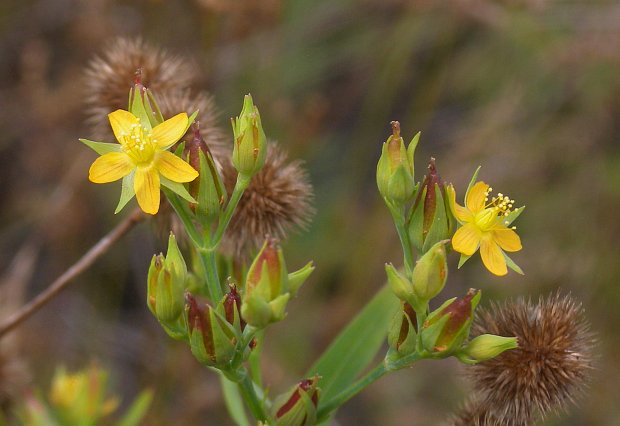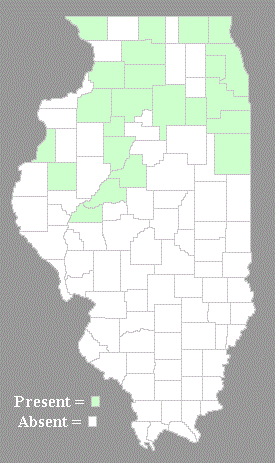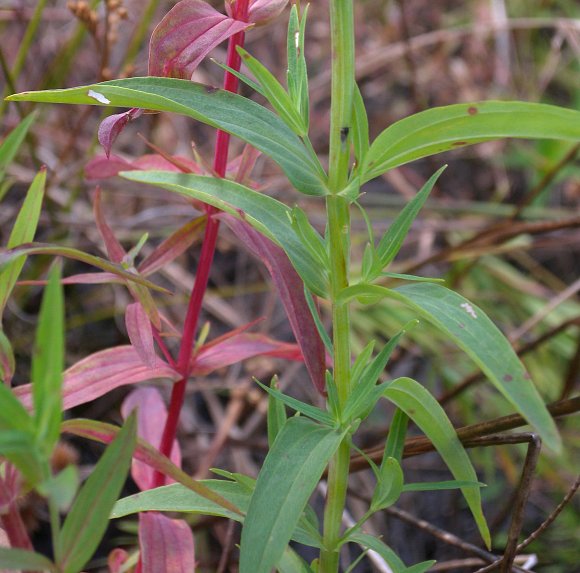Sand St. John's Wort
Hypericum majus
St. John's Wort family (Hypericaceae)
Hypericum majus
St. John's Wort family (Hypericaceae)
Description:
This herbaceous plant is a short-lived perennial that becomes 6–20"
(15–50 cm.) tall, often branching above. The hairless stems are light
green or light grayish green (sometimes bright purple later in the
year), 4-angled, and slightly winged. Pairs of opposite leaves occur at
intervals along the central stem and any developed secondary stems. The
leaves along the central stem are ¾–2" (2–5 cm.) long and ¼–½" (6–12
mm.) wide, lanceolate in shape, and toothless (smooth) along their
margins. The leaves along secondary stems are smaller in size and
more narrow in shape. The leaves usually clasp the stems at their bases
(less often, they are sessile), while their tips are pointed to blunt.
The upper surface of the leaves is dull grayish green, and hairless,
while the lower surface of the leaves is light grayish green and
hairless. However, sometimes they become light purple later in the
year. Depending on their size and width, individual leaves along the
central stem have 3–7
veins that originate from their bases. The smaller and more narrow
leaves along secondary stems, however, have only 1–3 veins.

The central stem terminates in a cluster of flowers that is somewhat flat-headed, spanning 2–5" (5–12.5 cm.) across. Upper secondary stems also terminate in clusters of flowers, but they are smaller in size, spanning 1–2" (2.5–5 cm.) across. The branches and pedicels of these inflorescences are light grayish green and 4-angled. Each flower is about 1/3" (8 mm.) across, consisting of 5 yellow petals, 5 light green sepals, 14-22 yellow stamens, and a light yellow pistil with 3 styles. The petals are oblong-elliptic in shape; they sometimes have fine reddish veins. The sepals are lanceolate in shape, faintly veined, and hairless. The petals are about the same length or a little shorter than the sepals. The blooming period occurs from mid-summer to early autumn, lasting about 1–1½ months for a colony of plants. Afterwards, seed capsules develop that become about 6–7 mm. long at maturity; they are lanceoloid-ovoid in
shape and quickly become purplish red or maroon. These capsules
eventually split open, releasing numerous tiny seeds. Individual seeds
are about 0.5 mm. long, light yellow to brown, and oblongoid in shape
with a faint network of pits and ridges; they are small enough to be
blown about by the wind or carried by water to new areas. The root
system sometimes produces rhizomes.
lanceoloid-ovoid in
shape and quickly become purplish red or maroon. These capsules
eventually split open, releasing numerous tiny seeds. Individual seeds
are about 0.5 mm. long, light yellow to brown, and oblongoid in shape
with a faint network of pits and ridges; they are small enough to be
blown about by the wind or carried by water to new areas. The root
system sometimes produces rhizomes.
Cultivation: The preference is full sun, wet to moist conditions, and low fertility soil containing some sand, silt, or gravel. Shallow standing water is tolerated if it is not too persistent.
Range & Habitat: Sand St. John's Wort (Hypericum majus) occurs in the northern half of Illinois, where it is uncommon and native, while in the southern half of the state it is absent. More broadly, this plant occurs primarily in the upper Midwest, New England area, and adjacent areas of Canada; it also occurs in the Nebraska sand hills and widely scattered areas elsewhere. Habitats include wet to moist sand prairies, swales in drier sand prairies, interdunal swales along Lake Michigan, sandy marshes, fens, margins of lakes and streams, and sandy ditches. This plant is usually found in higher quality natural areas.
Faunal Associations: Only pollen is available as a floral reward for pollinators of St. John's Wort (Hypericum) flowers. Typical floral visitors of these plants are bumblebees, Halictid bees (Lasioglossum spp. & others), and occasional beetles. Miscellaneous insects feed destructively on St. John's Wort species, including a flea beetle (Paria sellata), aphids (Aphis hyperici, Hyalomyzus sensoriatus), seed-eating larvae of a weevil (Anthonomus rutilus), and larvae of an oligolectic moth, the Grey Half-spot (Nedra ramosula); see Clark et al. (2004), Hottes & Frison (1931), Wilhelm & Rericha (2017), and Covell (1984/2005). The foliage of these plants, including Sand St. John's Wort (Hypericum majus), is somewhat toxic to mammalian herbivores, including livestock, because its consumption can irritate their digestive tracts and make their skin extra-sensitive to ultraviolet light.
Photographic Location: A wet to moist swale in a sand prairie at Bonnie's Prairie Nature Preserve in Iroquois County, Illinois.

Comments: This is one of several species of little-known St. John's Wort (Hypericum spp.); the foliage is rather conspicuous, particularly when it becomes purple, but the flowers are small. It is often confused with similar species, such as Dwarf St. John's Wort (Hypericum mutilum), Clasping-leaved St. John's Wort (Hypericum gymnanthum), and Canada St. John's Wort (Hypericum canadense). Sand St. John's Wort (Hypericum majus) has been considered a larger variety of Canada St. John's Wort in the past. It differs from Canada St. John's Wort primarily by having wider leaves and a more robust habit of growth. Sand St. John's Wort differs from Dwarf St. John's Wort by having leaves with more tapered tips and by having slightly larger flowers with more stamens. Similarly, Sand St. John's Wort differs from Clasping-leaved St. John's Wort by having slightly larger flowers with more stamens and larger seed capsules. The leaves of these latter two species have similar, but not identical, shapes. A scientific synonym of Sand St. John's Wort is Hypericum canadense majus, and other common names for this species are Large St. John's Wort and Larger Canada St. John's Wort.

The central stem terminates in a cluster of flowers that is somewhat flat-headed, spanning 2–5" (5–12.5 cm.) across. Upper secondary stems also terminate in clusters of flowers, but they are smaller in size, spanning 1–2" (2.5–5 cm.) across. The branches and pedicels of these inflorescences are light grayish green and 4-angled. Each flower is about 1/3" (8 mm.) across, consisting of 5 yellow petals, 5 light green sepals, 14-22 yellow stamens, and a light yellow pistil with 3 styles. The petals are oblong-elliptic in shape; they sometimes have fine reddish veins. The sepals are lanceolate in shape, faintly veined, and hairless. The petals are about the same length or a little shorter than the sepals. The blooming period occurs from mid-summer to early autumn, lasting about 1–1½ months for a colony of plants. Afterwards, seed capsules develop that become about 6–7 mm. long at maturity; they are
 lanceoloid-ovoid in
shape and quickly become purplish red or maroon. These capsules
eventually split open, releasing numerous tiny seeds. Individual seeds
are about 0.5 mm. long, light yellow to brown, and oblongoid in shape
with a faint network of pits and ridges; they are small enough to be
blown about by the wind or carried by water to new areas. The root
system sometimes produces rhizomes.
lanceoloid-ovoid in
shape and quickly become purplish red or maroon. These capsules
eventually split open, releasing numerous tiny seeds. Individual seeds
are about 0.5 mm. long, light yellow to brown, and oblongoid in shape
with a faint network of pits and ridges; they are small enough to be
blown about by the wind or carried by water to new areas. The root
system sometimes produces rhizomes.Cultivation: The preference is full sun, wet to moist conditions, and low fertility soil containing some sand, silt, or gravel. Shallow standing water is tolerated if it is not too persistent.
Range & Habitat: Sand St. John's Wort (Hypericum majus) occurs in the northern half of Illinois, where it is uncommon and native, while in the southern half of the state it is absent. More broadly, this plant occurs primarily in the upper Midwest, New England area, and adjacent areas of Canada; it also occurs in the Nebraska sand hills and widely scattered areas elsewhere. Habitats include wet to moist sand prairies, swales in drier sand prairies, interdunal swales along Lake Michigan, sandy marshes, fens, margins of lakes and streams, and sandy ditches. This plant is usually found in higher quality natural areas.
Faunal Associations: Only pollen is available as a floral reward for pollinators of St. John's Wort (Hypericum) flowers. Typical floral visitors of these plants are bumblebees, Halictid bees (Lasioglossum spp. & others), and occasional beetles. Miscellaneous insects feed destructively on St. John's Wort species, including a flea beetle (Paria sellata), aphids (Aphis hyperici, Hyalomyzus sensoriatus), seed-eating larvae of a weevil (Anthonomus rutilus), and larvae of an oligolectic moth, the Grey Half-spot (Nedra ramosula); see Clark et al. (2004), Hottes & Frison (1931), Wilhelm & Rericha (2017), and Covell (1984/2005). The foliage of these plants, including Sand St. John's Wort (Hypericum majus), is somewhat toxic to mammalian herbivores, including livestock, because its consumption can irritate their digestive tracts and make their skin extra-sensitive to ultraviolet light.
Photographic Location: A wet to moist swale in a sand prairie at Bonnie's Prairie Nature Preserve in Iroquois County, Illinois.

Comments: This is one of several species of little-known St. John's Wort (Hypericum spp.); the foliage is rather conspicuous, particularly when it becomes purple, but the flowers are small. It is often confused with similar species, such as Dwarf St. John's Wort (Hypericum mutilum), Clasping-leaved St. John's Wort (Hypericum gymnanthum), and Canada St. John's Wort (Hypericum canadense). Sand St. John's Wort (Hypericum majus) has been considered a larger variety of Canada St. John's Wort in the past. It differs from Canada St. John's Wort primarily by having wider leaves and a more robust habit of growth. Sand St. John's Wort differs from Dwarf St. John's Wort by having leaves with more tapered tips and by having slightly larger flowers with more stamens. Similarly, Sand St. John's Wort differs from Clasping-leaved St. John's Wort by having slightly larger flowers with more stamens and larger seed capsules. The leaves of these latter two species have similar, but not identical, shapes. A scientific synonym of Sand St. John's Wort is Hypericum canadense majus, and other common names for this species are Large St. John's Wort and Larger Canada St. John's Wort.